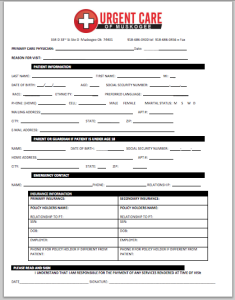5 Ways Urgent Care Can Handle Accommodation Paperwork

Introduction to Accommodation Paperwork in Urgent Care Settings

Handling accommodation paperwork in urgent care settings is a critical yet often overlooked aspect of providing comprehensive patient care. Accommodation requests, stemming from the Americans with Disabilities Act (ADA) and similar legislation worldwide, ensure that individuals with disabilities receive equitable access to medical services. Here’s how urgent care facilities can effectively manage these requests:
Efficient Documentation and Record Keeping

Keeping meticulous records is vital for addressing accommodation requests smoothly. Here’s how:
- Standardize Documentation: Create and use standardized forms for accommodation requests. This reduces errors and ensures no details are missed.
- Digital Solutions: Utilize digital records management systems. These systems can streamline the intake of accommodation requests, making them searchable and manageable.

Training Staff for Sensitivity and Compliance

Equip your staff with the right knowledge to manage requests:
- Training Sessions: Conduct regular training on ADA regulations, patient rights, and facility responsibilities. Include role-playing exercises to ensure staff can handle real-life situations.
- Ongoing Education: Stay updated on changing laws to ensure compliance with new regulations.
Facilitating Accessibility in Physical and Digital Spaces

Accommodation isn’t just about documentation:
- Physical Environment: Ensure waiting areas, examination rooms, and restrooms are wheelchair accessible, with ramps, lifts, and appropriate signage.
- Digital Accessibility: Websites and digital forms must comply with WCAG guidelines for people with visual or hearing impairments. Consider screen readers, alternative text for images, and proper color contrast.
🔍 Note: For individuals with visual impairments, ensuring websites and digital forms are accessible can significantly improve their ability to interact with medical services independently.
Streamlining Communication with Patients and Employers

Effective communication is crucial:
- Secure Communication Channels: Use secure communication tools to send and receive accommodation requests or updates.
- Clear Instructions: Provide patients with clear instructions on what information is needed and how to submit their requests.
- Employer Liaison: Establish protocols for communicating with employers when work-related accommodations are involved, ensuring privacy and compliance.
Legal Compliance and Proactive Advocacy

Adhering to legal requirements and promoting inclusivity:
- Legal Expertise: Consult with legal experts or ADA coordinators to ensure all practices align with the law.
- Proactive Policies: Develop policies that go beyond legal minimums to provide an inclusive environment. This might include:
- Offering alternative methods for communicating medical information (braille, large print).
- Training staff on sign language or offering interpreters for deaf patients.
Culmination of Efforts

By following these steps, urgent care facilities not only meet their legal obligations but also create a welcoming environment for all patients. The focus on efficient documentation, staff training, physical and digital accessibility, clear communication, and legal compliance ensures that urgent care centers can handle accommodation paperwork with proficiency and empathy. This approach not only enhances patient experience but also promotes inclusivity and accessibility, aligning with the core values of healthcare delivery.
What is the purpose of accommodation paperwork in urgent care?

+
The purpose is to ensure that individuals with disabilities receive appropriate accommodations to access medical services, comply with legal standards like the ADA, and promote an inclusive healthcare environment.
How does digital record-keeping benefit accommodation requests?

+
Digital record-keeping streamlines the process of managing and fulfilling accommodation requests. It allows for quicker retrieval of information, reduces errors, and ensures a paperless workflow, which is particularly useful for tracking and updating requests.
What are some steps to make a healthcare facility physically accessible?

+
Steps include installing ramps, accessible doors, elevators, and ensuring sufficient space for mobility aids like wheelchairs. Clear signage and wayfinding aids also help individuals navigate the facility independently.